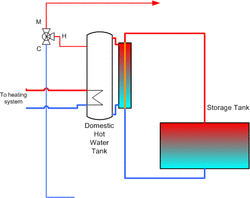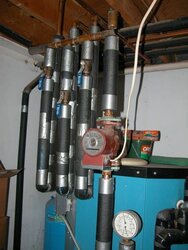I'm in my third year of heating with my Tarm and I never suspected that my Domestic hot water system is lacking. According to Chris @Tarm:
"Pressurized storage tanks do not normally have domestic hot water coils in them. Most options being used in North American are simple steel tanks, either factory fabricated for the purpose or modified LP tanks, etc. In most cases these tanks do not have a heat exchange coil in them and it is difficult to add one. This means that the heat exchange for domestic hot water production has to take place outside of the tank, typically this is done with an indirect water heater. The heat exchange coil that is built into the indirect is sized assuming 180 degree supply water temperature. This is not a problem when you are heating the indirect with the wood boiler or fossil fuel boiler, but when you are heating the indirect from storage, you will be using lower temperatures than that and the performance of the indirect drops off quickly. Even if the tank starts out at 180 degrees (or more), once you start to get below, say 160 degrees (150?), you can’t expect much hot water production from the indirect. This is all perfectly practical, but it does mean that you need to fire the boiler frequently enough to maintain high enough tank temperatures to meet your domestic hot water demand when you are running off of storage for a significant portion of the time, like in Summer.
An unpressurized tank system normally incorporates a heat exchange coil for domestic hot water production. It is easy to ‘oversize’ this coil so that it has enough surface area to produce acceptable amounts of domestic hot water at lower thermal storage tank temperatures, say down to 120 degrees tank temp. This coil is normally supplied directly from the well or city cold water supply and feeds into a more traditional water heater. The cold incoming water is heated, or pre-heated, before it gets to the water heater and the water heater only fires when the pre-heat from the thermal storage tank is insufficient. In an ideal, but expensive, scenario, the in-tank domestic hot water coil feeds a normal indirect water heater. This allows you to pre-heat the incoming cold water as described and simultaneously heat it via the coil built into the indirect. This gives even more heat exchange surface area and so allows for even lower tank temps. One of the things that people are looking for when they are thinking about heating domestic hot water with the wood boiler in the Summer, in my experience, is long coast times between wood boiler firings. I would suggest that the unpressurized tank system I described means the difference between firing once or twice per week and firing two or three times a week with the pressurized system I described.
There are of course many variables including storage volume and how much hot water is needed (retired couple or four kids and a ton of laundry?). Also, there are clearly other options like shell-in-tube or flat plate heat exchangers that can be used with pressurized storage to take advantage of lower tank temperatures. And, of course, if you are living in Europe , you can just buy a pressurized storage tank(s) that have over sized coils built in!
As I say, none of this is a hard and fast rule about pressurized vs unpressurized storage, but given the market as we see it and the technology available here, I think they are good rules of thumbs. I will be very interested to hear others’ thoughts on this, it is something that is very important to the industry and consumer and something that we continue to struggle with". Chris.
I have a 45 gallon superstore that seemed to work well with my pressurized storage. Now I'm wondering if I can upgrade my DHW system. I plan on burning all summer.
"Pressurized storage tanks do not normally have domestic hot water coils in them. Most options being used in North American are simple steel tanks, either factory fabricated for the purpose or modified LP tanks, etc. In most cases these tanks do not have a heat exchange coil in them and it is difficult to add one. This means that the heat exchange for domestic hot water production has to take place outside of the tank, typically this is done with an indirect water heater. The heat exchange coil that is built into the indirect is sized assuming 180 degree supply water temperature. This is not a problem when you are heating the indirect with the wood boiler or fossil fuel boiler, but when you are heating the indirect from storage, you will be using lower temperatures than that and the performance of the indirect drops off quickly. Even if the tank starts out at 180 degrees (or more), once you start to get below, say 160 degrees (150?), you can’t expect much hot water production from the indirect. This is all perfectly practical, but it does mean that you need to fire the boiler frequently enough to maintain high enough tank temperatures to meet your domestic hot water demand when you are running off of storage for a significant portion of the time, like in Summer.
An unpressurized tank system normally incorporates a heat exchange coil for domestic hot water production. It is easy to ‘oversize’ this coil so that it has enough surface area to produce acceptable amounts of domestic hot water at lower thermal storage tank temperatures, say down to 120 degrees tank temp. This coil is normally supplied directly from the well or city cold water supply and feeds into a more traditional water heater. The cold incoming water is heated, or pre-heated, before it gets to the water heater and the water heater only fires when the pre-heat from the thermal storage tank is insufficient. In an ideal, but expensive, scenario, the in-tank domestic hot water coil feeds a normal indirect water heater. This allows you to pre-heat the incoming cold water as described and simultaneously heat it via the coil built into the indirect. This gives even more heat exchange surface area and so allows for even lower tank temps. One of the things that people are looking for when they are thinking about heating domestic hot water with the wood boiler in the Summer, in my experience, is long coast times between wood boiler firings. I would suggest that the unpressurized tank system I described means the difference between firing once or twice per week and firing two or three times a week with the pressurized system I described.
There are of course many variables including storage volume and how much hot water is needed (retired couple or four kids and a ton of laundry?). Also, there are clearly other options like shell-in-tube or flat plate heat exchangers that can be used with pressurized storage to take advantage of lower tank temperatures. And, of course, if you are living in Europe , you can just buy a pressurized storage tank(s) that have over sized coils built in!
As I say, none of this is a hard and fast rule about pressurized vs unpressurized storage, but given the market as we see it and the technology available here, I think they are good rules of thumbs. I will be very interested to hear others’ thoughts on this, it is something that is very important to the industry and consumer and something that we continue to struggle with". Chris.
I have a 45 gallon superstore that seemed to work well with my pressurized storage. Now I'm wondering if I can upgrade my DHW system. I plan on burning all summer.




